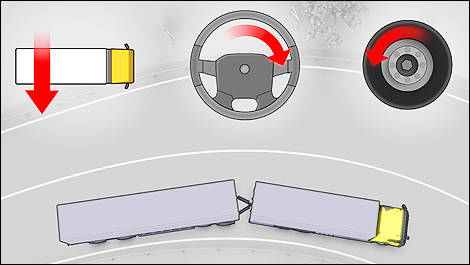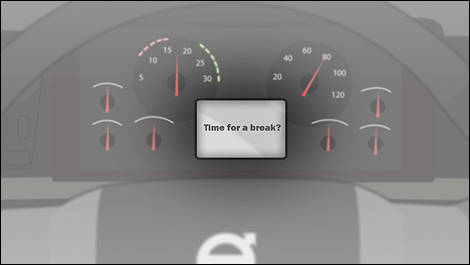"We invest heavily in research and are at the forefront in the development of this type of system. However, to make further progress towards the vision of zero accidents in traffic, vehicle manufacturers and society in general must collaborate," explains Carl-Johan Almqvist.
As part of this approach, Volvo Trucks is participating in a Europe-wide research project, Safespot, which is investigating how cars and trucks can communicate with one another and with the infrastructure in what are known as cooperative systems.
"The idea is to give the driver advanced relevant information about what is happening on the roads, based on data about the position and speed of other vehicles, road conditions and any obstacles there might be on the route. In order for this to function safely, it is necessary to have reliable and quick communication in a local network," relates Carl-Johan Almqvist, and adds:
"This type of technology must be exceptionally reliable and requires open, constructive collaboration between vehicle manufacturers and society. One of the main challenges is to find a standardized "language" for vehicle-infrastructure communication," says Almqvist.
Digital co-pilot
As part of an EU project called HAVEit (Highly Automated Vehicles for Intelligent Transport), Volvo Trucks is participating in the development of a digital co-pilot for trucks. A virtual guardian angel that keeps an alert watch on the road and surrounding traffic, ready to help or to step in should the driver lose control.
"Our main task is to support the driver and facilitate his or her job behind the wheel as much as possible. However, even as we approach the zero vision, technology can never take over responsibility for driving the truck. That role is and will remain the responsibility of the professional and skilled driver," says Carl Johan Almqvist.
Facts about Volvo's safety systems
- Driver Alert Support registers if the driver is drowsy by monitoring the truck's position between the road markings. The system alerts the driver if it concludes that the vehicle's progress on the road is erratic.
- Volvo's stability system, ESP (Electronic Stability Program), is regulated by a computer that receives information from a variety of sources, including the ABS brakes' wheel sensors, the steering system and a gyroscope. Using this information as a basis, the onboard computer can instantaneously determine if the truck is about to roll over or skid. ESP responds directly by individually braking one or more wheels on the truck and trailer. If necessary, the system can also lower engine revs.
- Lane Changing Support is a watchful "extra eye" that uses radar sensors to help the truck driver detect other vehicles in the offset rear blind spot on the passenger side. The driver is alerted via a visual signal in the A-post, accompanied by a warning buzzer.
photo:Volvo
 |
As part of this approach, Volvo Trucks is participating in a Europe-wide research project, Safespot, which is investigating how cars and trucks can communicate with one another and with the infrastructure in what are known as cooperative systems.
"The idea is to give the driver advanced relevant information about what is happening on the roads, based on data about the position and speed of other vehicles, road conditions and any obstacles there might be on the route. In order for this to function safely, it is necessary to have reliable and quick communication in a local network," relates Carl-Johan Almqvist, and adds:
"This type of technology must be exceptionally reliable and requires open, constructive collaboration between vehicle manufacturers and society. One of the main challenges is to find a standardized "language" for vehicle-infrastructure communication," says Almqvist.
Digital co-pilot
As part of an EU project called HAVEit (Highly Automated Vehicles for Intelligent Transport), Volvo Trucks is participating in the development of a digital co-pilot for trucks. A virtual guardian angel that keeps an alert watch on the road and surrounding traffic, ready to help or to step in should the driver lose control.
"Our main task is to support the driver and facilitate his or her job behind the wheel as much as possible. However, even as we approach the zero vision, technology can never take over responsibility for driving the truck. That role is and will remain the responsibility of the professional and skilled driver," says Carl Johan Almqvist.
Facts about Volvo's safety systems
- Driver Alert Support registers if the driver is drowsy by monitoring the truck's position between the road markings. The system alerts the driver if it concludes that the vehicle's progress on the road is erratic.
- Volvo's stability system, ESP (Electronic Stability Program), is regulated by a computer that receives information from a variety of sources, including the ABS brakes' wheel sensors, the steering system and a gyroscope. Using this information as a basis, the onboard computer can instantaneously determine if the truck is about to roll over or skid. ESP responds directly by individually braking one or more wheels on the truck and trailer. If necessary, the system can also lower engine revs.
- Lane Changing Support is a watchful "extra eye" that uses radar sensors to help the truck driver detect other vehicles in the offset rear blind spot on the passenger side. The driver is alerted via a visual signal in the A-post, accompanied by a warning buzzer.
 |
| Driver Alert Support (DAS) |
photo:Volvo


